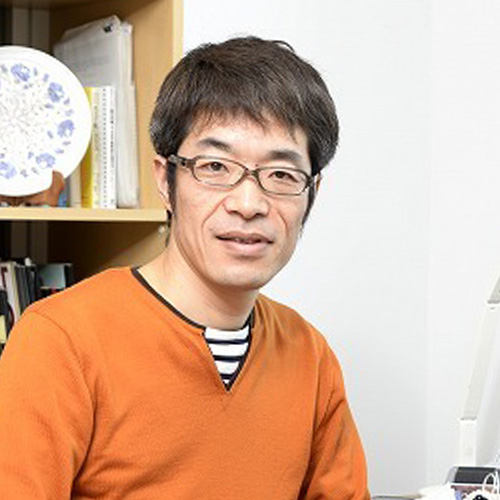Related Outline
Tatsuo Shibata has been working on problems of cell and developmental biology from perspectives of mathematical sciences such as physics and applied mathematics. He was among the first to focus on the importance of fluctuations in signal transduction systems. He theoretically clarified that the fluctuation in signal transduction reactions is the sum of the intrinsic and extrinsic noises. He also showed that there is a quantitative relationship between the signal amplification rate (gain) and the strength of the noise (Shibata and Fujimoto, PNAS 2005). This result was then applied to the chemotaxis of eukaryotic cell. He found that the signal-to-noise ratio of signal transduction reaction can well explain the results of the efficiency of chemotactic movement (Ueda and Shibata, Biophys J, 2007). This is evidence that fluctuation in the signaling reactions indeed affect cellular functions.
In the chemotaxis signal transduction system, cells form polarity autonomously (Arai, Shibata et al. PNAS 2010, Shibata et al J. Cell Sci. 2012). By using experimental and theoretical approaches, he and his colleague presented a model, in which an external chemotactic cue biases the direction of the autonomously formed polarity, enabling reliable information processing for direction detection, in spite of the fluctuation in the signal.
Such cell autonomous polarity formation was also found in zygote of c. elegans and epithelial cells (Lee & Shibata, J. Theor. Biol. 2015, Lim et al., Cell Rep. 2021). Coordination of such autonomous pattern formation induces an order in multicellular systems. He and his coworker showed that a coordination of migrating cells generates a density wave in multicellular system (Hayakawa et al. eLife 2020).
To clarify what cell mechanical process induces the three-dimensional deformation of epithelial sheet, a dynamical model was constructed to comprehensively examined the folding mechanisms. Deformation of basolateral membrane was found to be the key to induce deep fold (Wen et al. Biophys. J 2017). They also show that epithelial polarity forms feedback with cell mechanics, leading to autonomous epithelial folding (Wen et al. PLoS Comp Biol 2021).
He and his coworkers clarified principles that organize cell chirality among the cell population to induce unidirectional collective cell movement (Sato et al. Nat Comm. 2015, Sato et al. Phys Rev Lett. 2015, Yamamoto et al. Phys Rev Res. 2020). We are currently conducting research to clarify the mechanisms by which chirality appears in cells and multicellular systems, both experimentally and theoretically.
Career
Tatsuo Shibata received his Ph.D. from the University of Tokyo in 1999 for works in physics of complex systems. He did his postdoctoral work at Research Institute for Mathematical Sciences, Kyoto university and Fritz Haber Institute of Max-Planck Society, in Berlin, Germany. From 2002, he became a lecturer and then associate professor at Hiroshima university. From 2010, he joined RIKEN Center for Developmental Biology (CDB) as a unit leader. From 2015, he became a team leader at RIKEN Quantitative Biology Center (QBiC). From 2018, he is a team leader of Laboratory for Physical Biology at RIKEN Center for Biosystems Dynamics Research (BDR), Kobe.
Representative Achievements
- Autonomous epithelial folding induced by an intracellular mechano–polarity feedback loop.
Wen, F.-L., Kwan, C. W., Wang, Y.-C. & Shibata, T.
PLoS Comput Biol 17, e1009614 (2021).
DOI: https://doi.org/10.1371/journal.pcbi.1009614 - Polar pattern formation induced by contact following locomotion in a multicellular system.
Hayakawa, M., Hiraiwa, T., Wada, Y., Kuwayama, H. & Shibata, T.
Elife 9, e53609 (2020).
DOI: https://doi.org/10.7554/elife.53609 - Collective cell migration of epithelial cells driven by chiral torque generation.
Yamamoto, T., Hiraiwa, T. & Shibata, T.
Phys Rev Res 2, 043326 (2020).
DOI: https://doi.org/10.1103/physrevresearch.2.043326 - Epithelial Folding Driven by Apical or Basal-Lateral Modulation: Geometric Features, Mechanical Inference, and Boundary Effects.
Wen, F.-L., Wang, Y.-C. & Shibata, T.
Biophysical Journal 112, 2683–2695 (2017).
DOI: https://doi.org/10.1016/j.bpj.2017.05.012 - Cell Chirality Induces Collective Cell Migration in Epithelial Sheets.
Sato, K., Hiraiwa, T. & Shibata, T.
Phys Rev Lett 115, 188102 (2015).
DOI: https://doi.org/10.1103/physrevlett.115.188102 - Excitable Signal Transduction Induces Both Spontaneous and Directional Cell Asymmetries in the Phosphatidylinositol Lipid Signaling System for Eukaryotic Chemotaxis.
Nishikawa, M., Hörning, M., Ueda, M. & Shibata, T.
Biophys J 106, 723–734 (2014).
DOI: https://doi.org/10.1016/j.bpj.2013.12.023 - Scaling of Dorsal-Ventral Patterning by Embryo Size-Dependent Degradation of Spemann’s Organizer Signals.
Inomata, H., Shibata, T., Haraguchi, T. & Sasai, Y.
Cell 153, 1296–1311 (2013).
DOI: https://doi.org/10.1016/j.cell.2013.05.004 - Modeling the self-organized phosphatidylinositol lipid signaling system in chemotactic cells using quantitative image analysis.
Shibata, T., Nishikawa, M., Matsuoka, S. & Ueda, M.
J Cell Sci 125, 5138–5150 (2012).
DOI: https://doi.org/10.1242/jcs.108373 - Self-organization of the phosphatidylinositol lipids signaling system for random cell migration.
Arai, Y., Shibata, T., Matsuoka, S., Sato, M. J., Yanagida, T. & Ueda, M.
Proc National Acad Sci 107, 12399–12404 (2010).
DOI: https://doi.org/10.1073/pnas.0908278107 - Noisy signal amplification in ultrasensitive signal transduction.
Shibata, T. & Fujimoto, K.
Proc National Acad Sci 102, 331–336 (2005).
DOI: https://doi.org/10.1073/pnas.0403350102

